BSBMGT608 Manage Innovation and Continuous Improvement Report
VerifiedAdded on 2024/06/07
|28
|4754
|486
Report
AI Summary
This assignment solution provides a detailed analysis of quality management and continuous improvement theories, including total employee involvement, process-centered approaches, and customer-focused strategies. It discusses Kotter's 8-step change model, the diffusion of innovation theory, and the purpose of ISO 9000 standards. The document also explores cost-benefit analysis, the concept of a learning organization, the importance of shared vision and team learning, and sustainability practices in Australian workplaces. Furthermore, it defines risk according to the Australia/New Zealand Standard for Risk Management (AS/NZS ISO 31000:2009), outlines the risk management process, and presents a policies and procedures development project with an action plan for implementing continuous improvement and innovation initiatives. The report concludes with an analysis of the implemented initiatives.
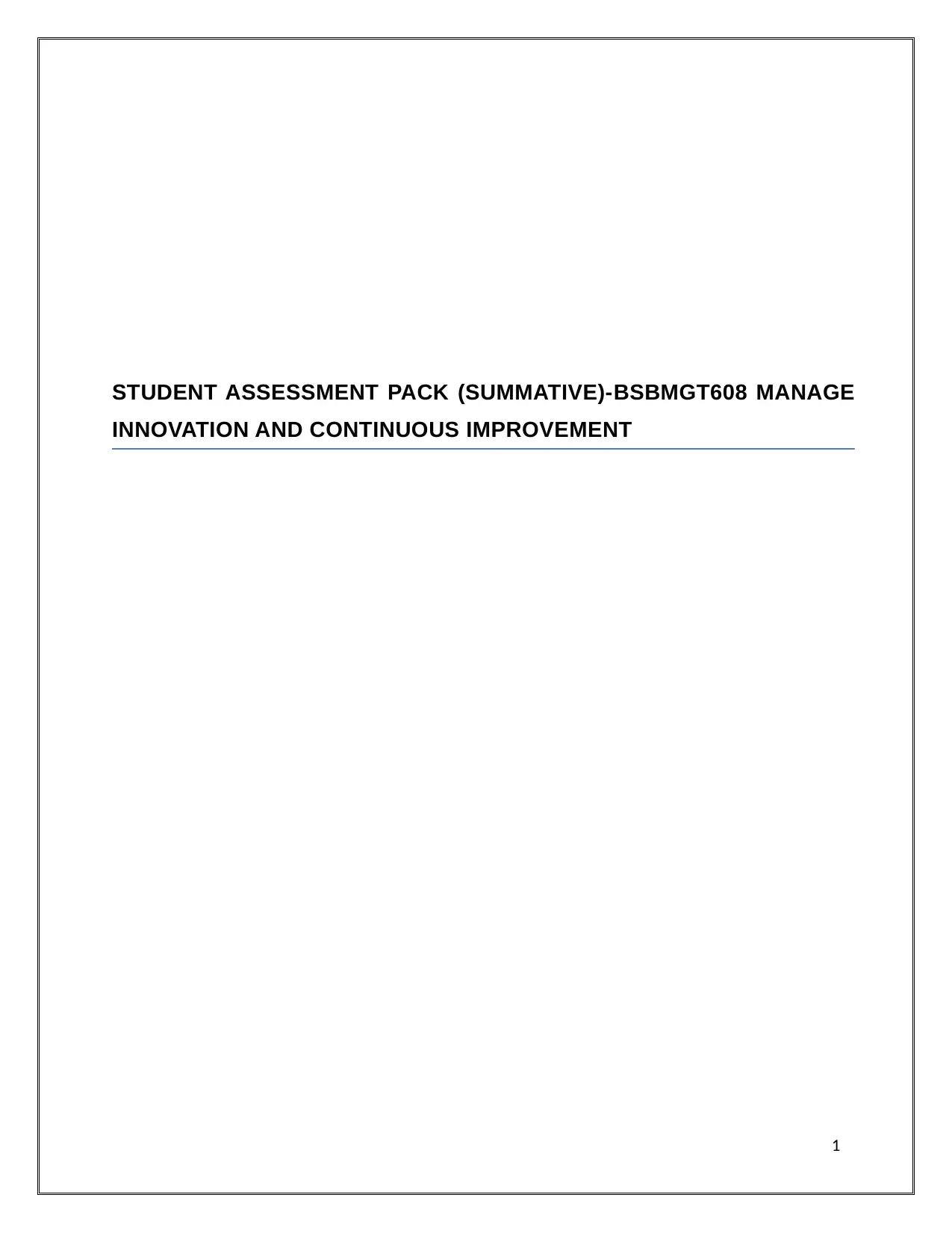
STUDENT ASSESSMENT PACK (SUMMATIVE)-BSBMGT608 MANAGE
INNOVATION AND CONTINUOUS IMPROVEMENT
1
INNOVATION AND CONTINUOUS IMPROVEMENT
1
Paraphrase This Document
Need a fresh take? Get an instant paraphrase of this document with our AI Paraphraser
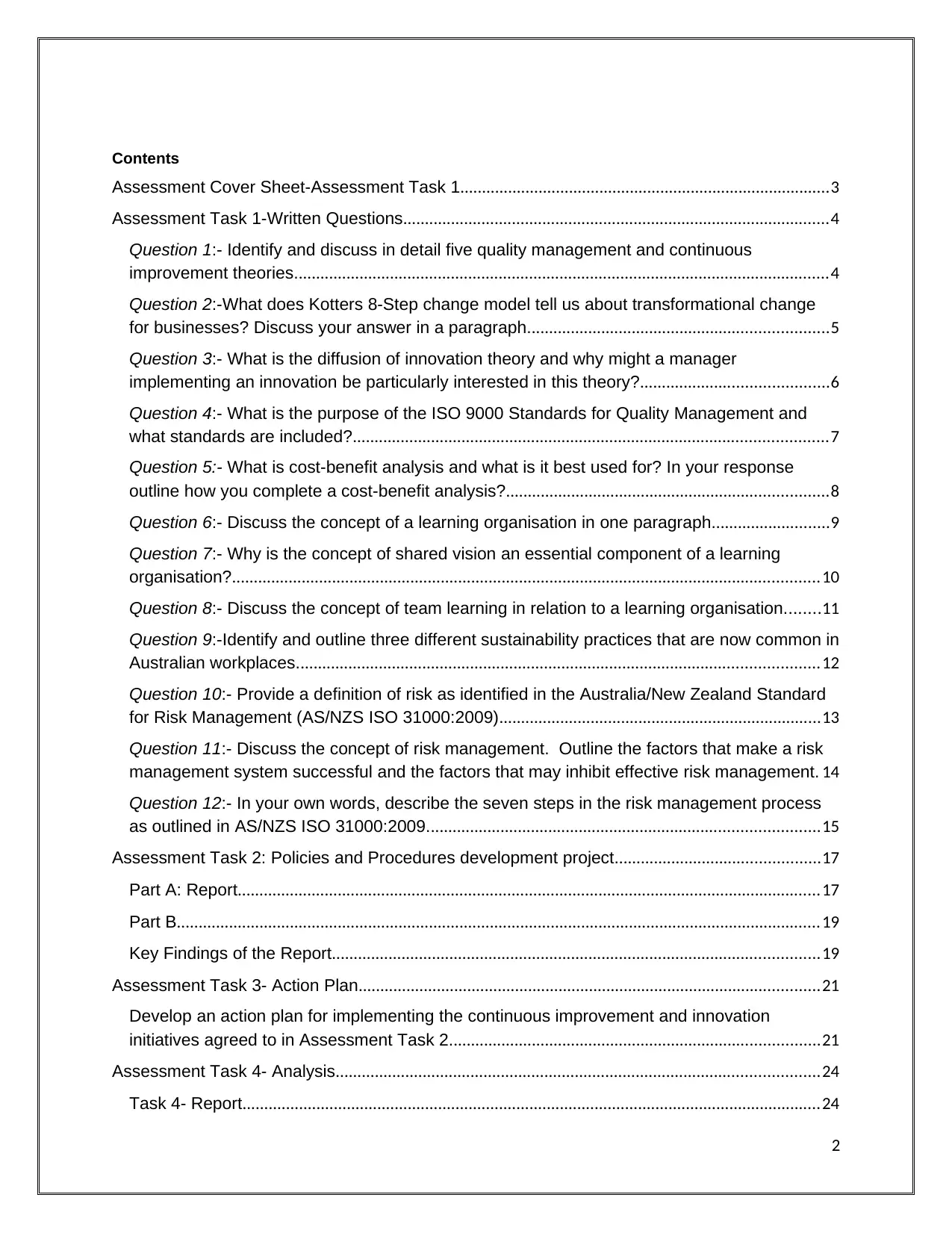
Contents
Assessment Cover Sheet-Assessment Task 1.....................................................................................3
Assessment Task 1-Written Questions..................................................................................................4
Question 1:- Identify and discuss in detail five quality management and continuous
improvement theories...........................................................................................................................4
Question 2:-What does Kotters 8-Step change model tell us about transformational change
for businesses? Discuss your answer in a paragraph.....................................................................5
Question 3:- What is the diffusion of innovation theory and why might a manager
implementing an innovation be particularly interested in this theory?...........................................6
Question 4:- What is the purpose of the ISO 9000 Standards for Quality Management and
what standards are included?.............................................................................................................7
Question 5:- What is cost-benefit analysis and what is it best used for? In your response
outline how you complete a cost-benefit analysis?..........................................................................8
Question 6:- Discuss the concept of a learning organisation in one paragraph...........................9
Question 7:- Why is the concept of shared vision an essential component of a learning
organisation?.......................................................................................................................................10
Question 8:- Discuss the concept of team learning in relation to a learning organisation........11
Question 9:-Identify and outline three different sustainability practices that are now common in
Australian workplaces........................................................................................................................12
Question 10:- Provide a definition of risk as identified in the Australia/New Zealand Standard
for Risk Management (AS/NZS ISO 31000:2009)..........................................................................13
Question 11:- Discuss the concept of risk management. Outline the factors that make a risk
management system successful and the factors that may inhibit effective risk management. 14
Question 12:- In your own words, describe the seven steps in the risk management process
as outlined in AS/NZS ISO 31000:2009..........................................................................................15
Assessment Task 2: Policies and Procedures development project...............................................17
Part A: Report......................................................................................................................................17
Part B....................................................................................................................................................19
Key Findings of the Report................................................................................................................19
Assessment Task 3- Action Plan..........................................................................................................21
Develop an action plan for implementing the continuous improvement and innovation
initiatives agreed to in Assessment Task 2.....................................................................................21
Assessment Task 4- Analysis...............................................................................................................24
Task 4- Report.....................................................................................................................................24
2
Assessment Cover Sheet-Assessment Task 1.....................................................................................3
Assessment Task 1-Written Questions..................................................................................................4
Question 1:- Identify and discuss in detail five quality management and continuous
improvement theories...........................................................................................................................4
Question 2:-What does Kotters 8-Step change model tell us about transformational change
for businesses? Discuss your answer in a paragraph.....................................................................5
Question 3:- What is the diffusion of innovation theory and why might a manager
implementing an innovation be particularly interested in this theory?...........................................6
Question 4:- What is the purpose of the ISO 9000 Standards for Quality Management and
what standards are included?.............................................................................................................7
Question 5:- What is cost-benefit analysis and what is it best used for? In your response
outline how you complete a cost-benefit analysis?..........................................................................8
Question 6:- Discuss the concept of a learning organisation in one paragraph...........................9
Question 7:- Why is the concept of shared vision an essential component of a learning
organisation?.......................................................................................................................................10
Question 8:- Discuss the concept of team learning in relation to a learning organisation........11
Question 9:-Identify and outline three different sustainability practices that are now common in
Australian workplaces........................................................................................................................12
Question 10:- Provide a definition of risk as identified in the Australia/New Zealand Standard
for Risk Management (AS/NZS ISO 31000:2009)..........................................................................13
Question 11:- Discuss the concept of risk management. Outline the factors that make a risk
management system successful and the factors that may inhibit effective risk management. 14
Question 12:- In your own words, describe the seven steps in the risk management process
as outlined in AS/NZS ISO 31000:2009..........................................................................................15
Assessment Task 2: Policies and Procedures development project...............................................17
Part A: Report......................................................................................................................................17
Part B....................................................................................................................................................19
Key Findings of the Report................................................................................................................19
Assessment Task 3- Action Plan..........................................................................................................21
Develop an action plan for implementing the continuous improvement and innovation
initiatives agreed to in Assessment Task 2.....................................................................................21
Assessment Task 4- Analysis...............................................................................................................24
Task 4- Report.....................................................................................................................................24
2
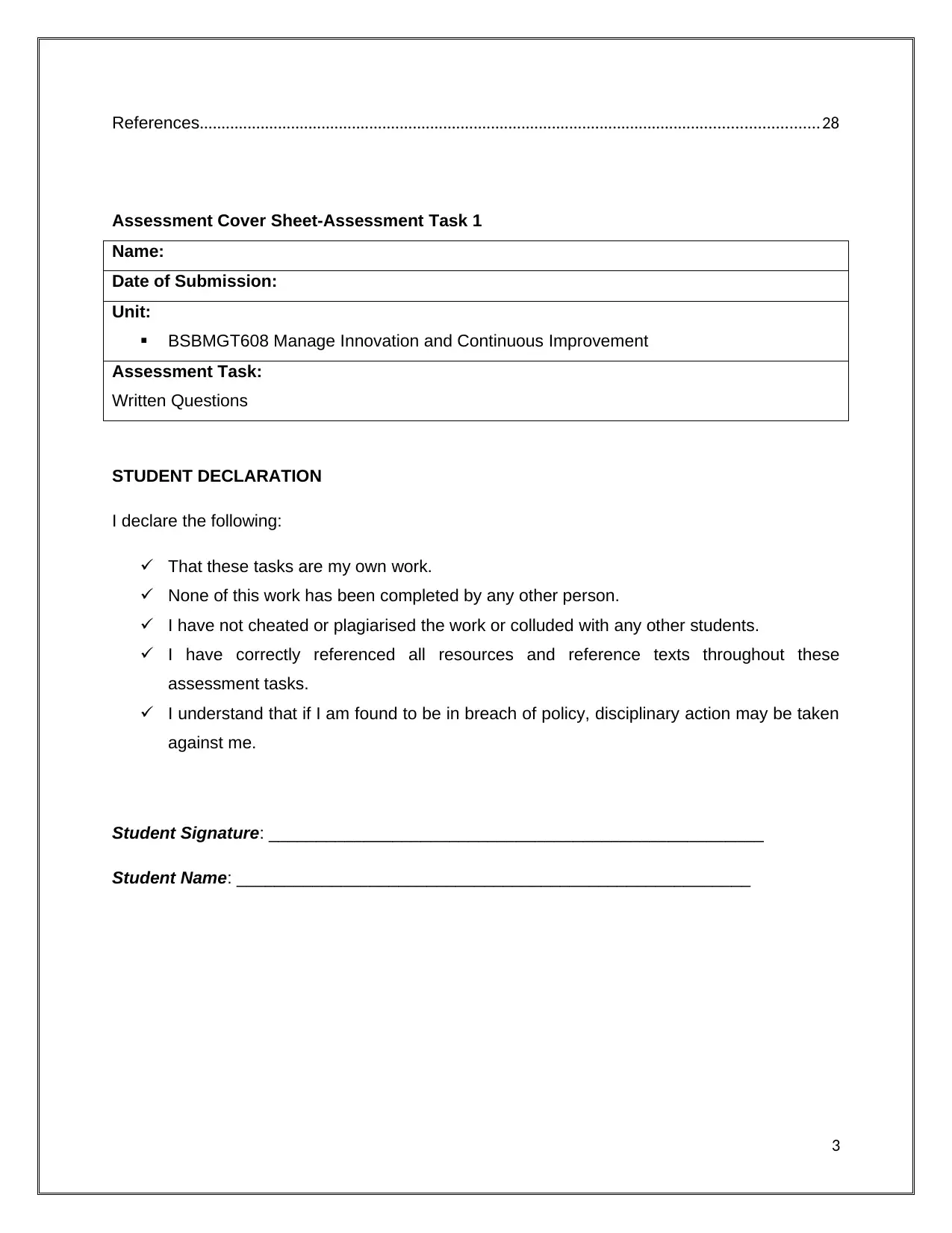
References..............................................................................................................................................28
Assessment Cover Sheet-Assessment Task 1
Name:
Date of Submission:
Unit:
BSBMGT608 Manage Innovation and Continuous Improvement
Assessment Task:
Written Questions
STUDENT DECLARATION
I declare the following:
That these tasks are my own work.
None of this work has been completed by any other person.
I have not cheated or plagiarised the work or colluded with any other students.
I have correctly referenced all resources and reference texts throughout these
assessment tasks.
I understand that if I am found to be in breach of policy, disciplinary action may be taken
against me.
Student Signature: ____________________________________________________
Student Name: ______________________________________________________
3
Assessment Cover Sheet-Assessment Task 1
Name:
Date of Submission:
Unit:
BSBMGT608 Manage Innovation and Continuous Improvement
Assessment Task:
Written Questions
STUDENT DECLARATION
I declare the following:
That these tasks are my own work.
None of this work has been completed by any other person.
I have not cheated or plagiarised the work or colluded with any other students.
I have correctly referenced all resources and reference texts throughout these
assessment tasks.
I understand that if I am found to be in breach of policy, disciplinary action may be taken
against me.
Student Signature: ____________________________________________________
Student Name: ______________________________________________________
3
⊘ This is a preview!⊘
Do you want full access?
Subscribe today to unlock all pages.

Trusted by 1+ million students worldwide
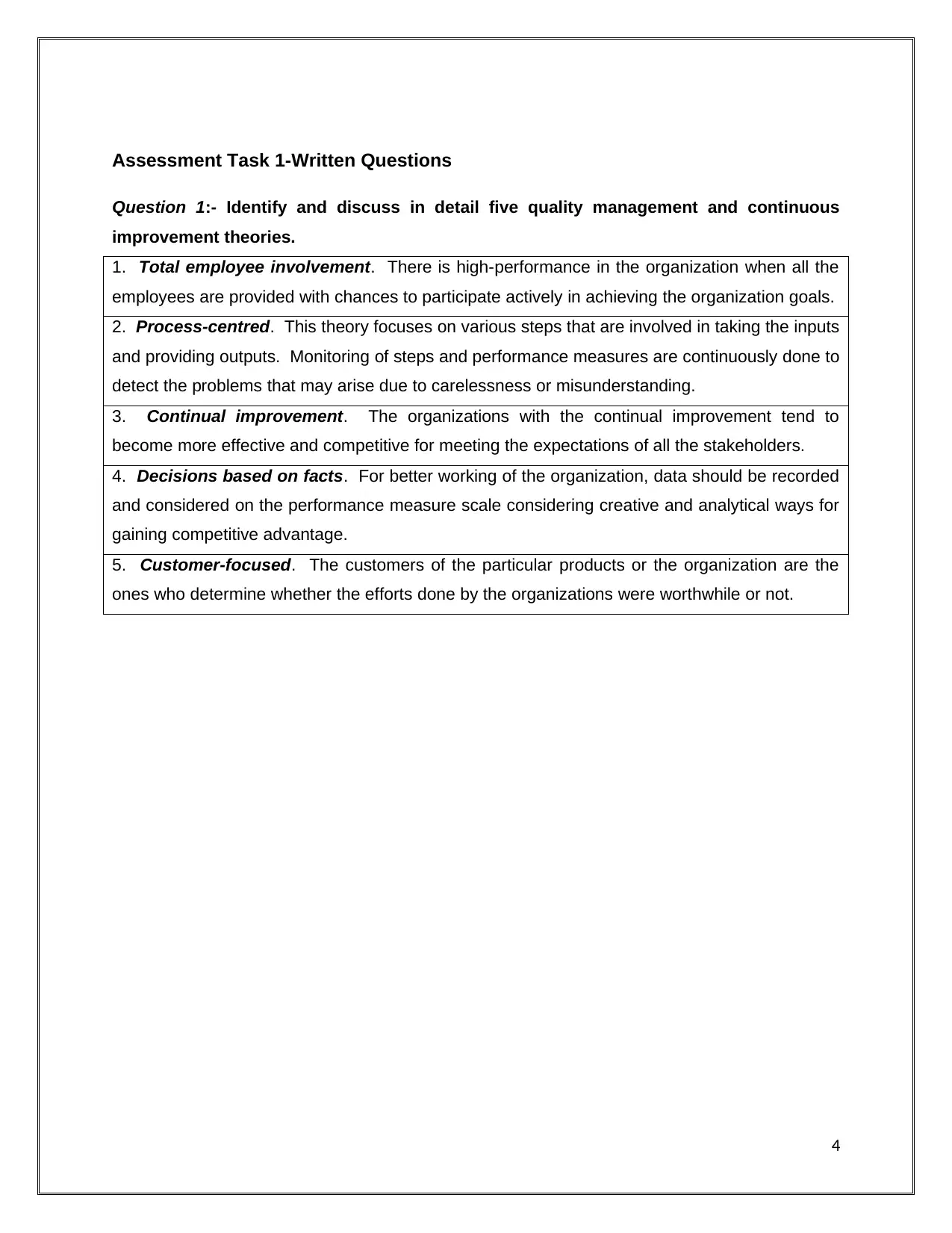
Assessment Task 1-Written Questions
Question 1:- Identify and discuss in detail five quality management and continuous
improvement theories.
1. Total employee involvement. There is high-performance in the organization when all the
employees are provided with chances to participate actively in achieving the organization goals.
2. Process-centred. This theory focuses on various steps that are involved in taking the inputs
and providing outputs. Monitoring of steps and performance measures are continuously done to
detect the problems that may arise due to carelessness or misunderstanding.
3. Continual improvement. The organizations with the continual improvement tend to
become more effective and competitive for meeting the expectations of all the stakeholders.
4. Decisions based on facts. For better working of the organization, data should be recorded
and considered on the performance measure scale considering creative and analytical ways for
gaining competitive advantage.
5. Customer-focused. The customers of the particular products or the organization are the
ones who determine whether the efforts done by the organizations were worthwhile or not.
4
Question 1:- Identify and discuss in detail five quality management and continuous
improvement theories.
1. Total employee involvement. There is high-performance in the organization when all the
employees are provided with chances to participate actively in achieving the organization goals.
2. Process-centred. This theory focuses on various steps that are involved in taking the inputs
and providing outputs. Monitoring of steps and performance measures are continuously done to
detect the problems that may arise due to carelessness or misunderstanding.
3. Continual improvement. The organizations with the continual improvement tend to
become more effective and competitive for meeting the expectations of all the stakeholders.
4. Decisions based on facts. For better working of the organization, data should be recorded
and considered on the performance measure scale considering creative and analytical ways for
gaining competitive advantage.
5. Customer-focused. The customers of the particular products or the organization are the
ones who determine whether the efforts done by the organizations were worthwhile or not.
4
Paraphrase This Document
Need a fresh take? Get an instant paraphrase of this document with our AI Paraphraser
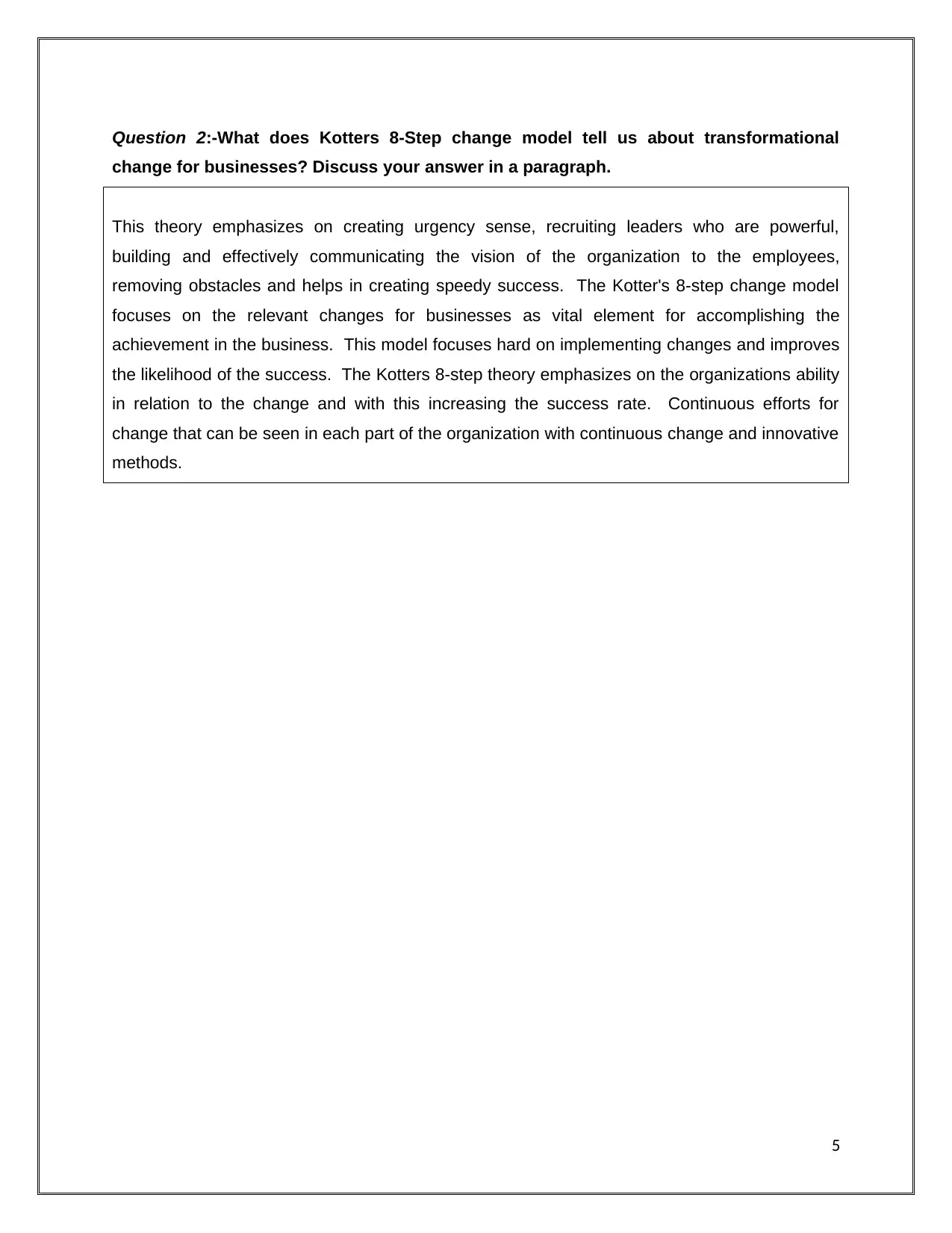
Question 2:-What does Kotters 8-Step change model tell us about transformational
change for businesses? Discuss your answer in a paragraph.
This theory emphasizes on creating urgency sense, recruiting leaders who are powerful,
building and effectively communicating the vision of the organization to the employees,
removing obstacles and helps in creating speedy success. The Kotter's 8-step change model
focuses on the relevant changes for businesses as vital element for accomplishing the
achievement in the business. This model focuses hard on implementing changes and improves
the likelihood of the success. The Kotters 8-step theory emphasizes on the organizations ability
in relation to the change and with this increasing the success rate. Continuous efforts for
change that can be seen in each part of the organization with continuous change and innovative
methods.
5
change for businesses? Discuss your answer in a paragraph.
This theory emphasizes on creating urgency sense, recruiting leaders who are powerful,
building and effectively communicating the vision of the organization to the employees,
removing obstacles and helps in creating speedy success. The Kotter's 8-step change model
focuses on the relevant changes for businesses as vital element for accomplishing the
achievement in the business. This model focuses hard on implementing changes and improves
the likelihood of the success. The Kotters 8-step theory emphasizes on the organizations ability
in relation to the change and with this increasing the success rate. Continuous efforts for
change that can be seen in each part of the organization with continuous change and innovative
methods.
5
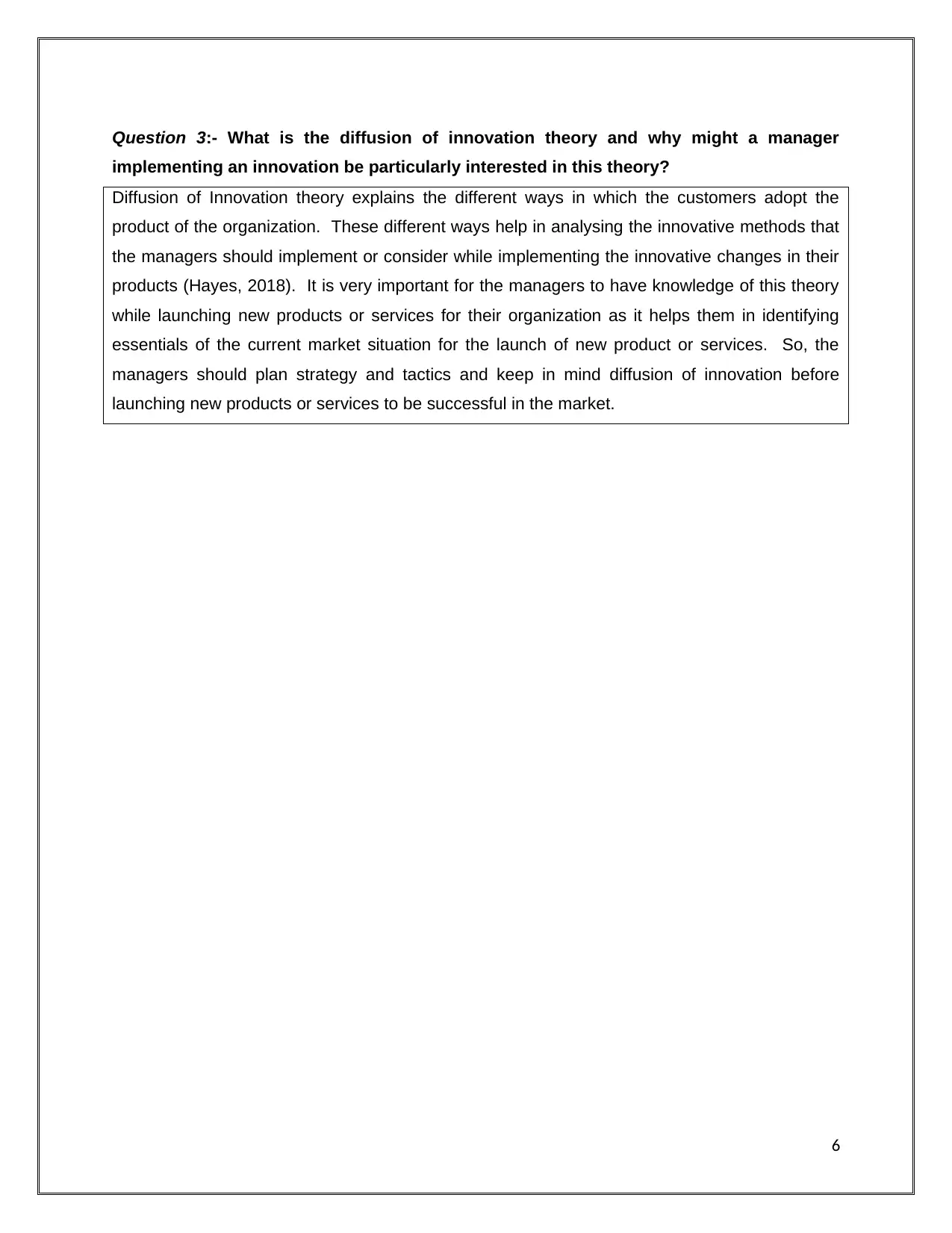
Question 3:- What is the diffusion of innovation theory and why might a manager
implementing an innovation be particularly interested in this theory?
Diffusion of Innovation theory explains the different ways in which the customers adopt the
product of the organization. These different ways help in analysing the innovative methods that
the managers should implement or consider while implementing the innovative changes in their
products (Hayes, 2018). It is very important for the managers to have knowledge of this theory
while launching new products or services for their organization as it helps them in identifying
essentials of the current market situation for the launch of new product or services. So, the
managers should plan strategy and tactics and keep in mind diffusion of innovation before
launching new products or services to be successful in the market.
6
implementing an innovation be particularly interested in this theory?
Diffusion of Innovation theory explains the different ways in which the customers adopt the
product of the organization. These different ways help in analysing the innovative methods that
the managers should implement or consider while implementing the innovative changes in their
products (Hayes, 2018). It is very important for the managers to have knowledge of this theory
while launching new products or services for their organization as it helps them in identifying
essentials of the current market situation for the launch of new product or services. So, the
managers should plan strategy and tactics and keep in mind diffusion of innovation before
launching new products or services to be successful in the market.
6
⊘ This is a preview!⊘
Do you want full access?
Subscribe today to unlock all pages.

Trusted by 1+ million students worldwide
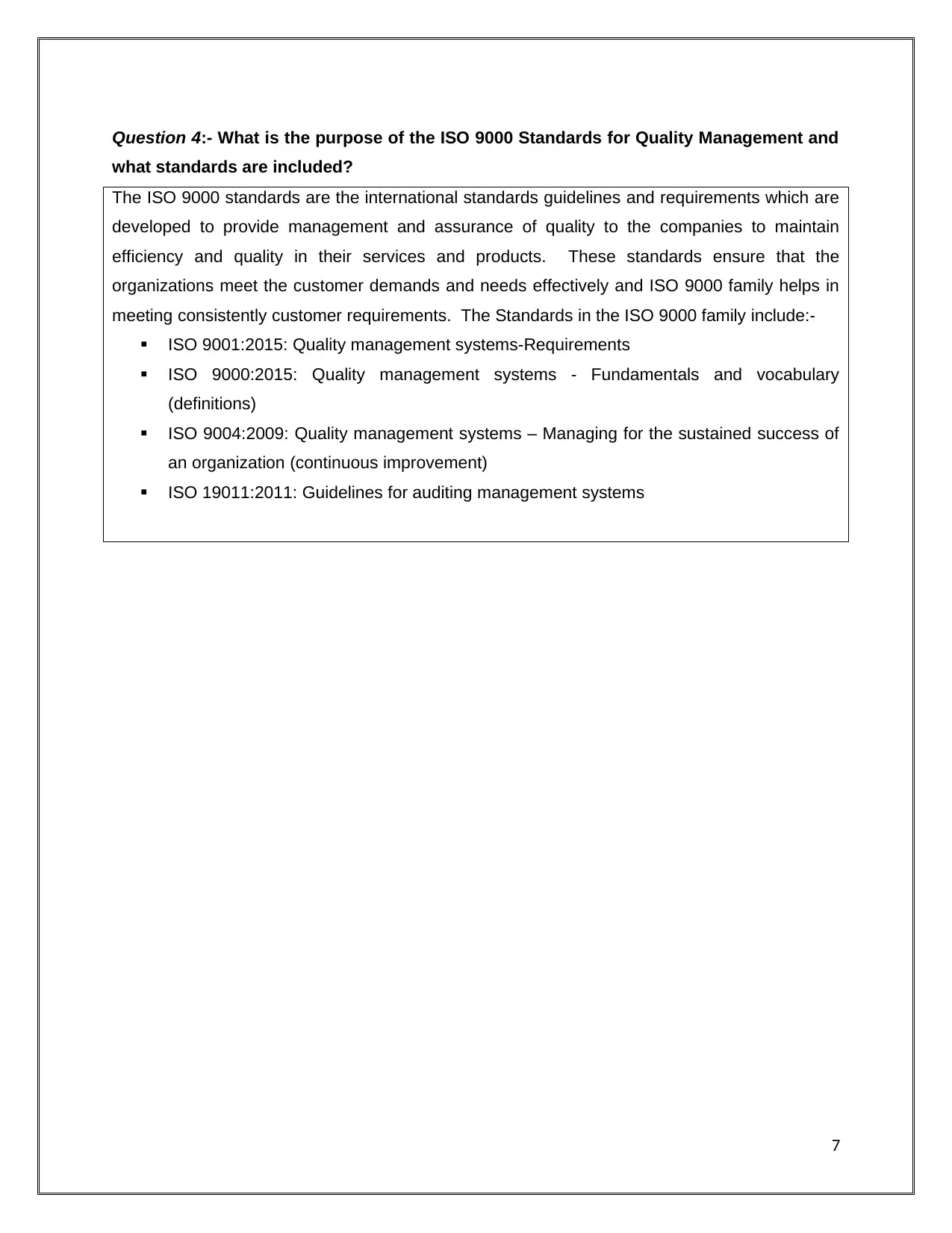
Question 4:- What is the purpose of the ISO 9000 Standards for Quality Management and
what standards are included?
The ISO 9000 standards are the international standards guidelines and requirements which are
developed to provide management and assurance of quality to the companies to maintain
efficiency and quality in their services and products. These standards ensure that the
organizations meet the customer demands and needs effectively and ISO 9000 family helps in
meeting consistently customer requirements. The Standards in the ISO 9000 family include:-
ISO 9001:2015: Quality management systems-Requirements
ISO 9000:2015: Quality management systems - Fundamentals and vocabulary
(definitions)
ISO 9004:2009: Quality management systems – Managing for the sustained success of
an organization (continuous improvement)
ISO 19011:2011: Guidelines for auditing management systems
7
what standards are included?
The ISO 9000 standards are the international standards guidelines and requirements which are
developed to provide management and assurance of quality to the companies to maintain
efficiency and quality in their services and products. These standards ensure that the
organizations meet the customer demands and needs effectively and ISO 9000 family helps in
meeting consistently customer requirements. The Standards in the ISO 9000 family include:-
ISO 9001:2015: Quality management systems-Requirements
ISO 9000:2015: Quality management systems - Fundamentals and vocabulary
(definitions)
ISO 9004:2009: Quality management systems – Managing for the sustained success of
an organization (continuous improvement)
ISO 19011:2011: Guidelines for auditing management systems
7
Paraphrase This Document
Need a fresh take? Get an instant paraphrase of this document with our AI Paraphraser
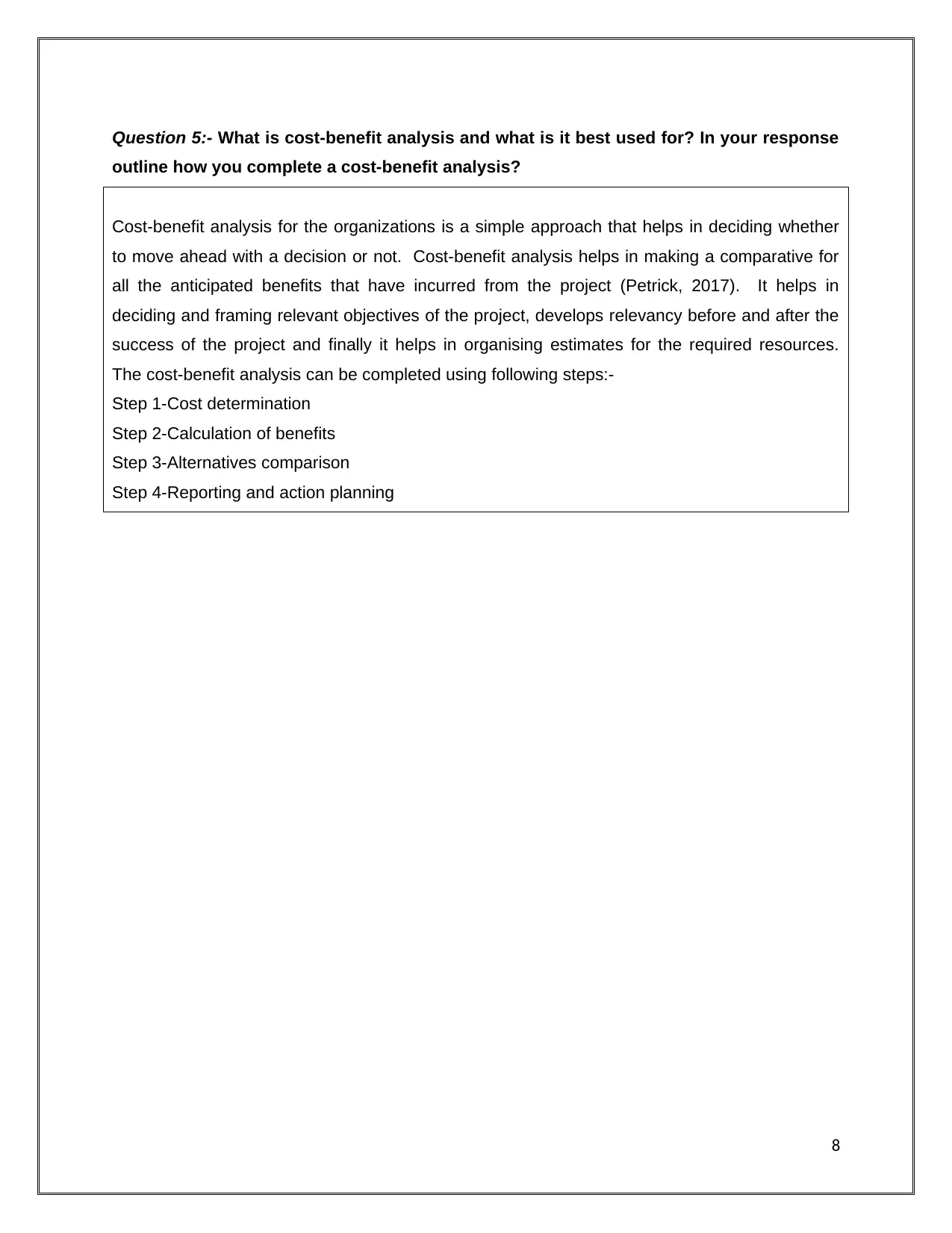
Question 5:- What is cost-benefit analysis and what is it best used for? In your response
outline how you complete a cost-benefit analysis?
Cost-benefit analysis for the organizations is a simple approach that helps in deciding whether
to move ahead with a decision or not. Cost-benefit analysis helps in making a comparative for
all the anticipated benefits that have incurred from the project (Petrick, 2017). It helps in
deciding and framing relevant objectives of the project, develops relevancy before and after the
success of the project and finally it helps in organising estimates for the required resources.
The cost-benefit analysis can be completed using following steps:-
Step 1-Cost determination
Step 2-Calculation of benefits
Step 3-Alternatives comparison
Step 4-Reporting and action planning
8
outline how you complete a cost-benefit analysis?
Cost-benefit analysis for the organizations is a simple approach that helps in deciding whether
to move ahead with a decision or not. Cost-benefit analysis helps in making a comparative for
all the anticipated benefits that have incurred from the project (Petrick, 2017). It helps in
deciding and framing relevant objectives of the project, develops relevancy before and after the
success of the project and finally it helps in organising estimates for the required resources.
The cost-benefit analysis can be completed using following steps:-
Step 1-Cost determination
Step 2-Calculation of benefits
Step 3-Alternatives comparison
Step 4-Reporting and action planning
8
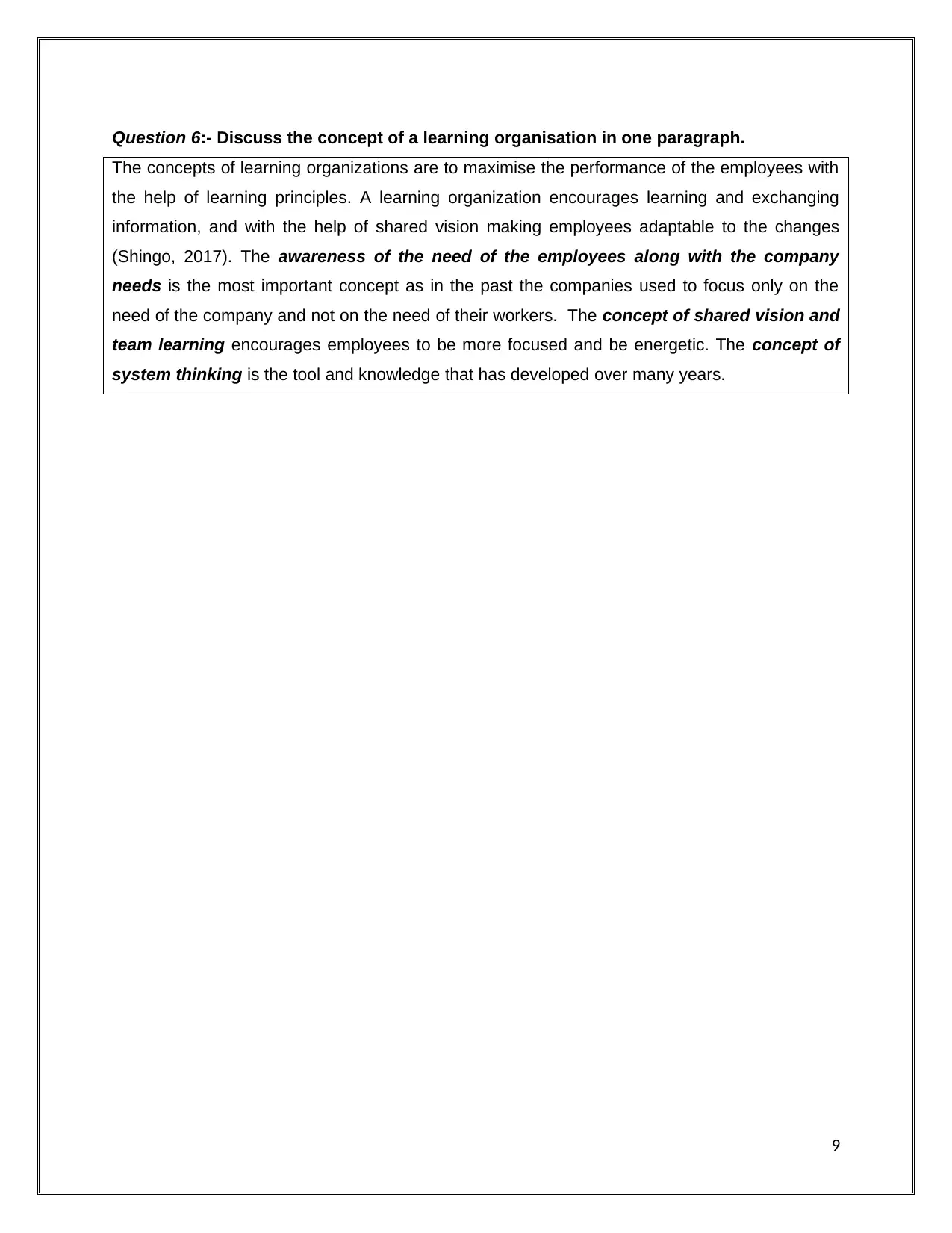
Question 6:- Discuss the concept of a learning organisation in one paragraph.
The concepts of learning organizations are to maximise the performance of the employees with
the help of learning principles. A learning organization encourages learning and exchanging
information, and with the help of shared vision making employees adaptable to the changes
(Shingo, 2017). The awareness of the need of the employees along with the company
needs is the most important concept as in the past the companies used to focus only on the
need of the company and not on the need of their workers. The concept of shared vision and
team learning encourages employees to be more focused and be energetic. The concept of
system thinking is the tool and knowledge that has developed over many years.
9
The concepts of learning organizations are to maximise the performance of the employees with
the help of learning principles. A learning organization encourages learning and exchanging
information, and with the help of shared vision making employees adaptable to the changes
(Shingo, 2017). The awareness of the need of the employees along with the company
needs is the most important concept as in the past the companies used to focus only on the
need of the company and not on the need of their workers. The concept of shared vision and
team learning encourages employees to be more focused and be energetic. The concept of
system thinking is the tool and knowledge that has developed over many years.
9
⊘ This is a preview!⊘
Do you want full access?
Subscribe today to unlock all pages.

Trusted by 1+ million students worldwide
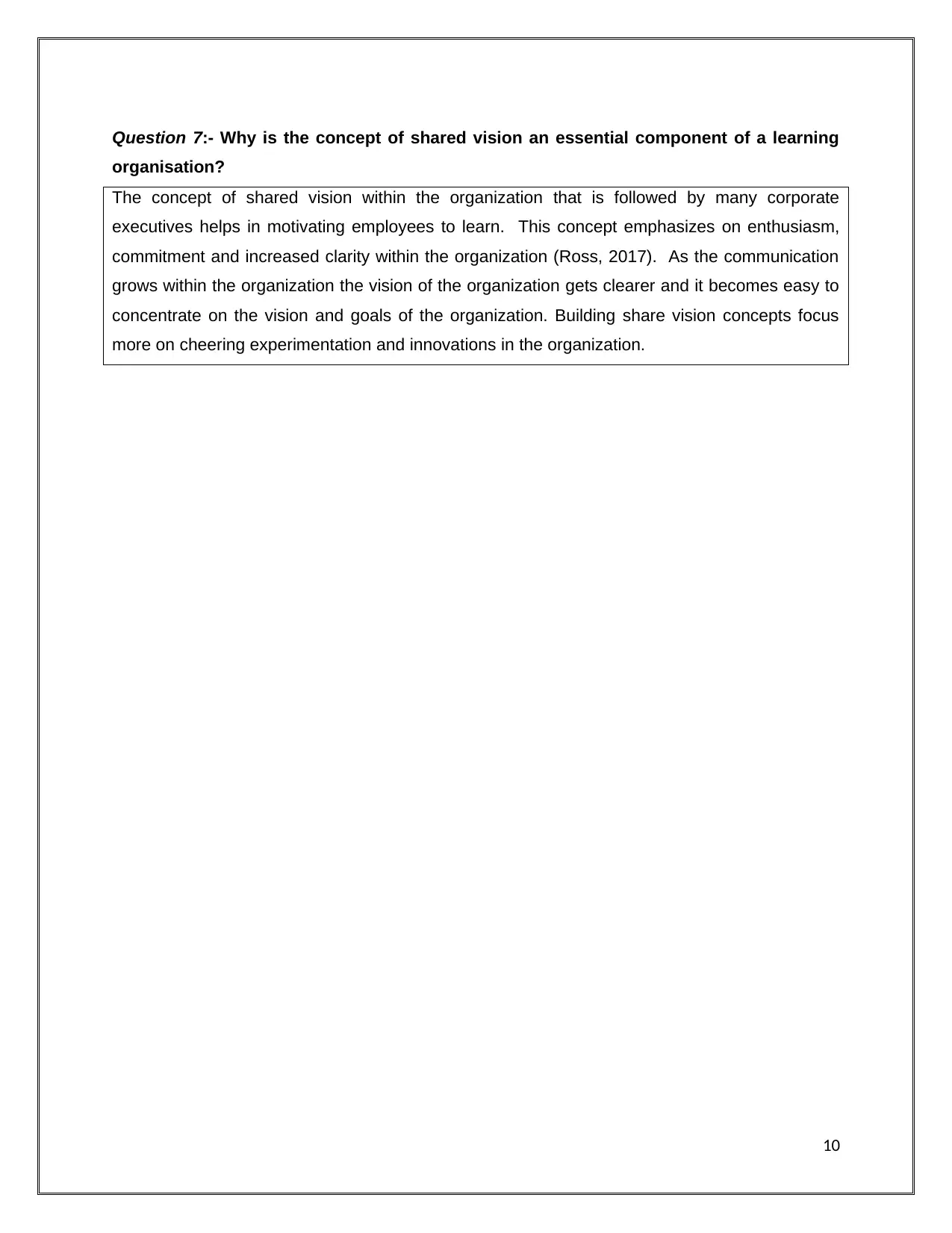
Question 7:- Why is the concept of shared vision an essential component of a learning
organisation?
The concept of shared vision within the organization that is followed by many corporate
executives helps in motivating employees to learn. This concept emphasizes on enthusiasm,
commitment and increased clarity within the organization (Ross, 2017). As the communication
grows within the organization the vision of the organization gets clearer and it becomes easy to
concentrate on the vision and goals of the organization. Building share vision concepts focus
more on cheering experimentation and innovations in the organization.
10
organisation?
The concept of shared vision within the organization that is followed by many corporate
executives helps in motivating employees to learn. This concept emphasizes on enthusiasm,
commitment and increased clarity within the organization (Ross, 2017). As the communication
grows within the organization the vision of the organization gets clearer and it becomes easy to
concentrate on the vision and goals of the organization. Building share vision concepts focus
more on cheering experimentation and innovations in the organization.
10
Paraphrase This Document
Need a fresh take? Get an instant paraphrase of this document with our AI Paraphraser
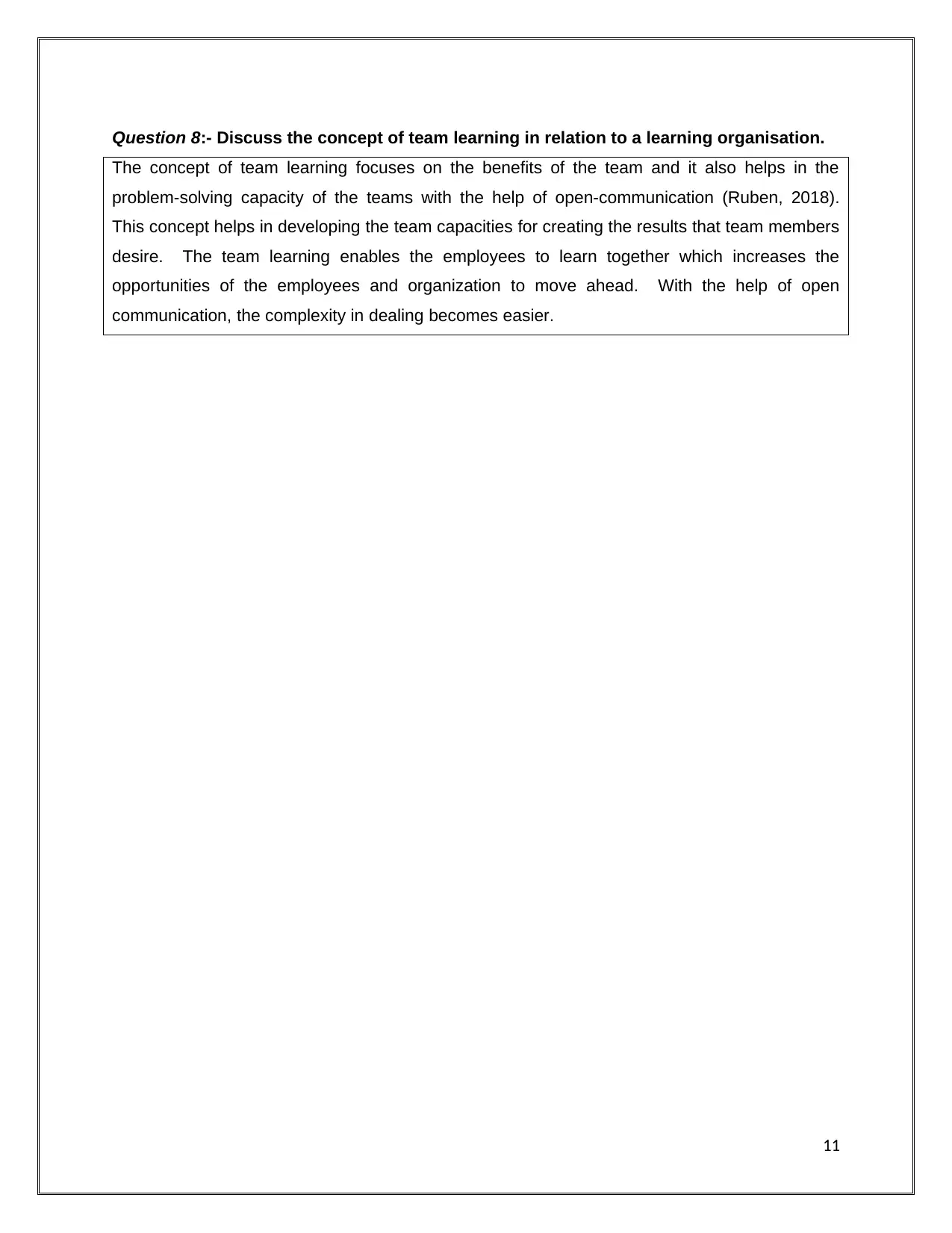
Question 8:- Discuss the concept of team learning in relation to a learning organisation.
The concept of team learning focuses on the benefits of the team and it also helps in the
problem-solving capacity of the teams with the help of open-communication (Ruben, 2018).
This concept helps in developing the team capacities for creating the results that team members
desire. The team learning enables the employees to learn together which increases the
opportunities of the employees and organization to move ahead. With the help of open
communication, the complexity in dealing becomes easier.
11
The concept of team learning focuses on the benefits of the team and it also helps in the
problem-solving capacity of the teams with the help of open-communication (Ruben, 2018).
This concept helps in developing the team capacities for creating the results that team members
desire. The team learning enables the employees to learn together which increases the
opportunities of the employees and organization to move ahead. With the help of open
communication, the complexity in dealing becomes easier.
11
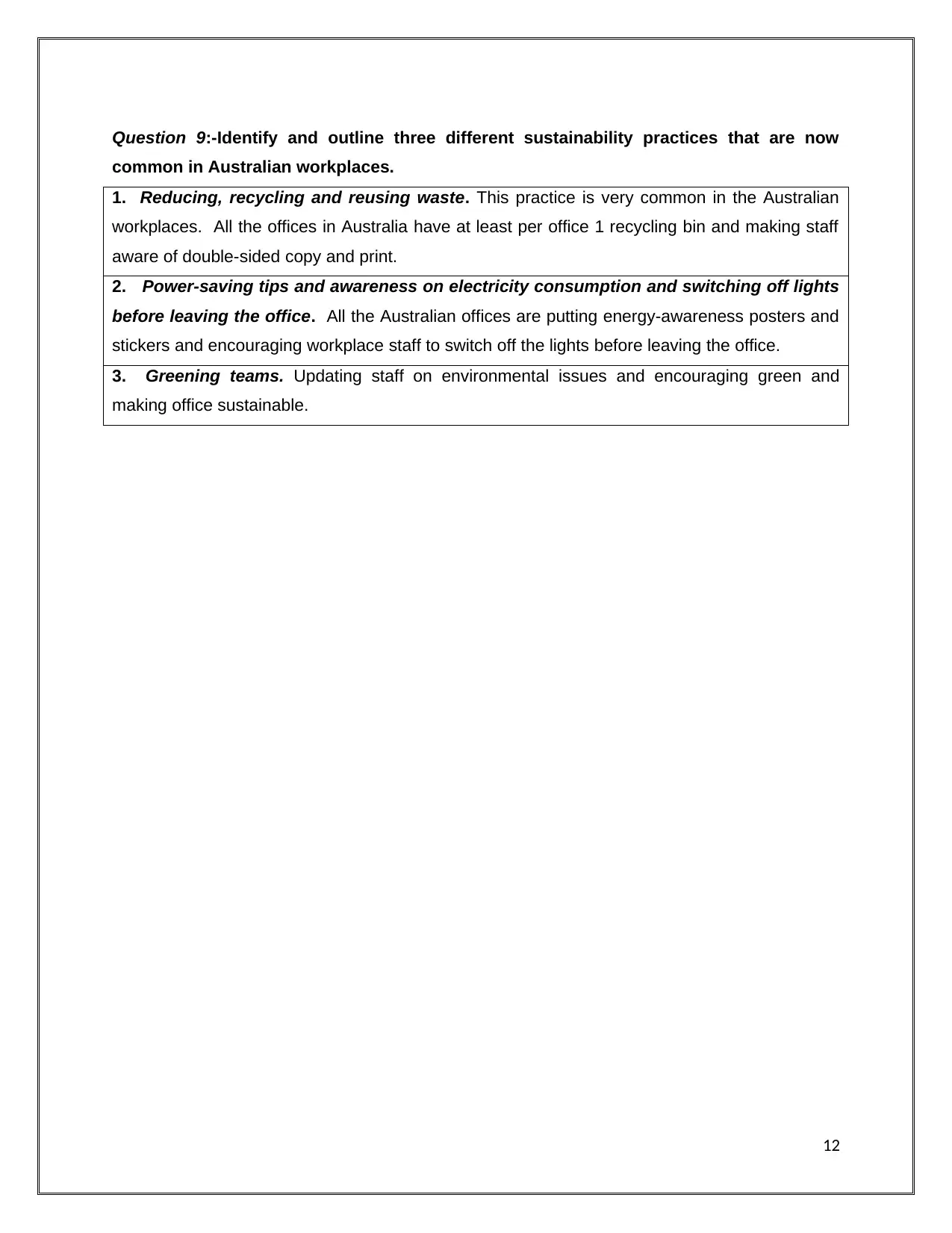
Question 9:-Identify and outline three different sustainability practices that are now
common in Australian workplaces.
1. Reducing, recycling and reusing waste. This practice is very common in the Australian
workplaces. All the offices in Australia have at least per office 1 recycling bin and making staff
aware of double-sided copy and print.
2. Power-saving tips and awareness on electricity consumption and switching off lights
before leaving the office. All the Australian offices are putting energy-awareness posters and
stickers and encouraging workplace staff to switch off the lights before leaving the office.
3. Greening teams. Updating staff on environmental issues and encouraging green and
making office sustainable.
12
common in Australian workplaces.
1. Reducing, recycling and reusing waste. This practice is very common in the Australian
workplaces. All the offices in Australia have at least per office 1 recycling bin and making staff
aware of double-sided copy and print.
2. Power-saving tips and awareness on electricity consumption and switching off lights
before leaving the office. All the Australian offices are putting energy-awareness posters and
stickers and encouraging workplace staff to switch off the lights before leaving the office.
3. Greening teams. Updating staff on environmental issues and encouraging green and
making office sustainable.
12
⊘ This is a preview!⊘
Do you want full access?
Subscribe today to unlock all pages.

Trusted by 1+ million students worldwide
1 out of 28
Related Documents
Your All-in-One AI-Powered Toolkit for Academic Success.
+13062052269
info@desklib.com
Available 24*7 on WhatsApp / Email
![[object Object]](/_next/static/media/star-bottom.7253800d.svg)
Unlock your academic potential
Copyright © 2020–2025 A2Z Services. All Rights Reserved. Developed and managed by ZUCOL.




